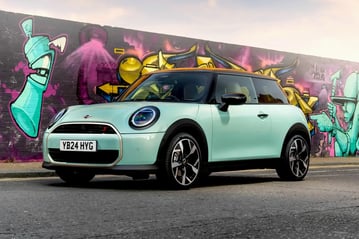- Carmoola
- Blog
- Cars and Gadgets
- What are the best group 1 insurance cars?
- 🗞 Cars and Gadgets
- Last updated: Apr 14, 2025
- 12 Min Read
What are the best group 1 insurance cars?
Written by

Verified by


See how much you can borrow in 60 seconds
| Representative Example | |
|---|---|
| Loan amount | £10,000 |
| Interest rate | 13.9% APR |
| 54 payments of | £246 |
| Total cost of credit | £3,284 |
| Option to purchase fee | £1 |
| Total payable | £13,285 |
Car insurance… don’t you just love it? Not only is it an unavoidable cost of running a car, it also happens to be one of the most expensive. You know you’re in for a shock when the renewal quote comes in, which prompts a frantic search on a price comparison site for a better deal. So, no, you don’t love it.
Fortunately, there is what we like to describe as a ‘cheat code’ for car insurance, and it comes in the form of the group ratings. More specifically, cars in group 1. Buy one of these cars and you’ll almost certainly pay less than your mates with more expensive cars, which means you’ll have more money to spend on the better things in life.
Carmoola is here to reveal some of the best group 1 insurance cars, along with some of the factors used to decide how much you’ll pay for your annual premium.
What is group 1 insurance?
Every car sold in the UK is assigned an insurance group rating from one to 50, and although several factors determine how much you’ll pay for cover, a car in a lower group should cost less to insure than one in a higher group.
As a rough guide, the car you learned to drive in is likely to be in one of the lowest groups, while the sort of sports car your dad fancies owning during his mid-life crisis will be in the highest groups. It’s all about risk, so cars in group 1 are seen as the lowest risk, while group 50 cars are at the opposite end of the risk spectrum.
You should be looking at cars in groups 1-5 if you’re a new or young driver, but check out our guide to insurance groups for more information.

What affects insurance premiums?
Insurance companies use the group rating to quantify the risk associated with every car in the UK. Without getting bogged down with the finer details, data and technical information is fed into Thatcham Research’s database, which is passed to the ABI (Association of British Insurance) Group Rating panel on a weekly basis.
- The panel takes into account 125 factors, which can be split into four categories:
- The cost and time it takes to return a car to its original condition after a claim
- The price of the car, including trim levels and specification, in the event of a total loss
- The car’s performance, including the acceleration, top speed and weight
- The car’s design, including security and safety equipment
At the time of writing, car insurance group ratings are being phased out and being replaced by a five assessment Vehicle Risk Rating (VRR) model. The new assessments are performance, damageability, repairability, safety and security, with each one scored from 1 (low risk) to 99 (high risk).
A spokesperson for Thatcham Research said: “It is important to note that new vehicles will be assessed against the current group rating system which will be in operation for at least the next 18 months, during which time the scores will continue to be published.”
Although a car’s insurance group has a big influence on how much you’ll pay for cover, the following factors will also affect your premium:
- Your age: a lack of experience and a higher risk of being involved in a collision means that young people pay more for insurance. Cheaper insurance is one of the perks of getting older!
- Your postcode: it’ll cost more to insure a car if you live in a built-up area or one with a high crime rate
- Your job: high-pressure and stressful jobs are considered high risk, so you’ll pay more if you use your car for commuting
- Your driving history: any accidents, claims or convictions will have a negative impact on how much you pay for insurance. On the flip side, a clean driving licence and no claims will help to reduce your premium
- Your marital status: insurance tends to be cheaper when you add a spouse to the policy, especially if they have a history of no claims
- Where you park: insurers will take into account where your car is parked overnight, which could be in a garage, on a driveway, in a car park or on a street
- Mileage: the more you drive, the more you’ll pay, so make sure you provide an accurate forecast when you’re searching for quotes
- Modifications: changes are likely to result in a higher premium, so think twice before you add bigger wheels, spoilers or an audio upgrade for your banging tunes
With the boring stuff out of the way, here are some of the best group 1 insurance cars for young and new drivers. It’s worth noting that many of the cars fall into more than one insurance group, so do your homework before making a choice.
Best group 1 insurance cars for new drivers
Volkswagen Polo
The Volkswagen Polo has always been a popular choice for new drivers, not least because it’s the car your parents would want you to drive. As well as having a high-quality look and feel, the Polo has the right badge, which, let’s be honest, is a big thing when you’re buying your first wheels. Strong demand means it’ll be worth more than many other small cars when you want to upgrade to something bigger or faster.
But here’s the really good news: we’re talking about the current Volkswagen Polo; the one that’s been on sale since 2017, so it’s got the latest tech, including a fabulous infotainment system. You’re limited to the 1.0-litre non-turbocharged engine, but the group 1 rating covers several different trim levels.

Skoda Fabia
The bad news is, there are no versions of the current Skoda Fabia in group 1, but don’t worry, because the old model (2015-2021) is just as good and there are lots to choose from. It may not have the ‘right’ badge, but the Fabia is a Polo underneath, so it’s like paying Primark prices for something from Prada.
Again, you’ll have to make do with the 1.0-litre non-turbo engine for the cheapest insurance, but while it lacks a bit of punch on motorways, it’s fine for nipping into town for some retail therapy. Avoid the basic S trim because the SE, SE Drive and Colour Edition are more desirable.

Chevrolet Spark
Remember the Chevrolet Spark? Probably not, but it’s a cheap and cheerful way into the group 1 club. And we do mean cheap, because prices start from around £1,000, although you might have to put up with a few battle scars and a missing wheel trim or two. Still, nobody said group 1 cars were glamorous.
Besides, you can tell your mates you drive a Chevy, which sounds cooler than a Skoda, right? Although the Spark is a little dated in some areas, it’s reasonably practical for a small car and easy to drive. The only downside is that you’re limited to the basic version with a 1.0-litre engine. Just think of the no-claims bonus you’re building up…

Best group 1 insurance cars for fuel efficiency
Seat Mii
If you’re after a great city car that’s cheap to insure, you really ought to take a Seat. A Seat Mii, to be precise, which shares many of its oily bits with the Volkswagen Up but is cheaper to buy. The Up was more popular, which means there are fewer Seats to go around, which leaves us searching in vain for a gag about musical chairs.
Moving on, the Seat Mii was available with three or five doors, with the latter being the more practical of the two. Don’t let its size fool you, because the Mii is surprisingly spacious inside, with enough room for four adults. Pick the 1.0-litre non-turbo engine for group 1 insurance, but pick from a choice of four trims: S, Ecomotive, SE and Toca.

Skoda Citigo
We could cut and paste our words about the Seat Mii, because the Skoda Citigo is another small car that shares a lot in common with the Volkswagen Up. It’s actually cheaper to buy than both the Up and the Mii, so it’s the one to choose if you don’t want to spend big on a small car.
Again, you’ll need the 1.0-litre engine (badged MPI) for the cheapest insurance, but around 55mpg is achievable in daily use. The three-door version is fine if it’s just you and your significant other, but your mates won’t thank you for making them climb into the back. Pick the five-door Citigo if that’s likely to be a problem.

Smart Forfour
As the name suggests, the Smart Forfour is the four-seat version of the Fortwo city car. We reckon it’s the better option, because along with the extra seats in the back, the Forfour has a bigger boot and additional storage areas. You can even turn it into a two-seater with an even larger boot by folding the rear seats.
It’s brilliant in the city, where its tiny dimensions and tight turning circle make it easy to park and squeeze through narrow streets where an SUV dare not enter. The only downside is that you’re limited to the entry-level Pure trim and a wheezy 1.0-litre engine, but the official 67.3mpg is a reason to be cheerful.

Best group 1 insurance cars for reliability
Hyundai i10
If you remember one car from our list of the best group 1 insurance cars for new drivers, it should be the Hyundai i10. Not just because it’s one of the most reliable small cars in the UK, but because it’s backed by a transferable five-year unlimited mileage warranty. Which means if you buy it new, you can pass it on to the next owner. Sharing is caring, or something.
The other bit of good news is that there are plenty to choose from, including a few versions of the current model and several of the old i10 on sale from 2014 until 2020. For price, choice and value for money, we’d choose the old version, but for the latest tech and the longest warranty, we’d go new.

Volkswagen Up
If we couldn’t convince you to buy a Seat Mii or Skoda Citigo, we’re going to make one final attempt with the Volkswagen Up. The VW badge makes it the most desirable of the three and there are some seriously cool trim levels to choose from, some with a group 1 insurance rating.
The High Up has 15-inch alloy wheels, heated front seats, a neat infotainment system and an array of cosmetic upgrades, while the Up Beats has a 300-watt stereo with 8-channel amplifier for playing “Moving On Up” by M People, “Word Up” by Cameo and “Running Up That Hill” by Kate Bush. Other, ahem, uplifting songs are available.

Kia Picanto
And finally, it’s the Kia Picanto, up there alongside the Hyundai i10 as one of the UK’s most reliable small cars. Like the i10, it has a long warranty, but while Hyundai offers a five-year unlimited mileage warranty, Kia offers cover for seven years or 100,000 miles, whichever comes soonest. In a small car, the mileage cap is unlikely to be an issue.
The current Picanto is a little gem, with funky styling, a cool interior, five-door practicality and a decent level of kit. Although only the 1.0-litre ‘2’ model gets a group 1 rating, it does have 14-inch alloy wheels, a touchscreen infotainment system with sat-nav, Apple CarPlay and Android Auto, plus manual air conditioning. At around £16,000, it’s one of the UK’s cheapest new cars.
FAQs about group 1 insurance cars
What are the best cars for young drivers?
The best cars for young drivers are small, inexpensive, safe, reliable and fuel-efficient. They need to be cheap to insure, so look for cars in groups 1-10 with a 1.0-litre engine. Avoid anything expensive or powerful until you’ve got some driving experience under your belt.
What car is best for a 17-year-old?
You should start by narrowing the search to small cars with a 1.0-litre engine. Good examples include the Volkswagen Polo, Ford Fiesta and Vauxhall Corsa, along with the likes of the Kia Picanto, Hyundai i10 and Renault Clio.
What is the cheapest car to tax and insure?
The trick here is to look at a car registered between 1 March 2001 and 31 March 2017, when some petrol and diesel cars qualified for free road tax (VED) thanks to CO2 emissions up to 100g/km. Examples that are also cheap to insure include some versions of the Ford Fiesta, Volkswagen Citigo, Peugeot 108 and Kia Picanto.
See how much you can borrow in 60 seconds
| Representative Example | |
|---|---|
| Loan amount | £10,000 |
| Interest rate | 13.9% APR |
| 54 payments of | £246 |
| Total cost of credit | £3,284 |
| Option to purchase fee | £1 |
| Total payable | £13,285 |
Related articles
Does Financing a Car Build Your Credit?
Financing a car can build credit when you make payments on time, but it can damage your score if you miss payments or take on...
Car Refinancing: What Is It and How It Can Lower Your Monthly Payments
Refinancing your car can give you benefits like lowering your monthly payments or reducing interest costs, depending on your...
Can you drive in the UK on a foreign licence?
If you’re new to the UK, you might be keen to get behind the wheel to explore on the open road. You can usually drive in the UK...

.webp?width=832&height=592&name=customer-support%20(1).webp)










.webp?width=400&height=285&name=online-shoppers-with-dog%20(1).webp)


.jpg?width=500&height=356&name=Vintage%20car%20going%20to%20an%20old%20town-1%20(1).jpg)





